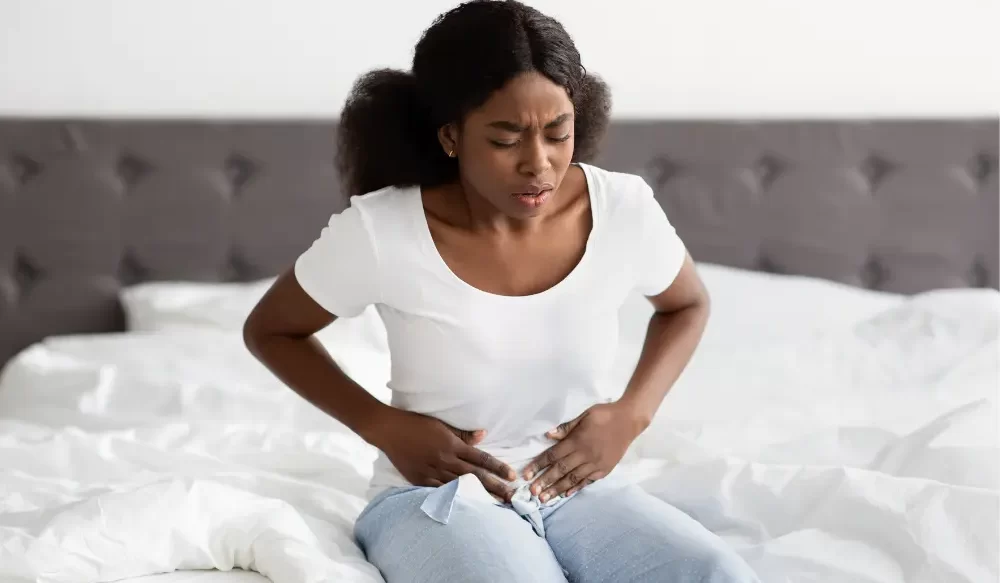Dysmenorrhea
Move Better. Live Fuller. Your Wellness Journey Starts Here.
Schedule a FREE Discovery Call!
What Is Dysmenorrhea?
Dysmenorrhea is a medical term that refers to menstrual cramps, or pain that is associated with menstruation (periods). Period pain can range from mild to severe, and is often accompanied by other symptoms that vary from person to person.
While each person is different, many people who have periods experience some level of pain during each menstruation, and may also experience the following symptoms:
- Nausea and vomiting
- Headaches
- Body aches (in the low back, genitals, breasts, and more)
- Fatigue
- Pelvic pain

There are two types of dysmenorrhea:
- Primary dysmenorrhea: Pain before or during the period that begins as the uterine lining starts to shed. This pain is not caused by other conditions.
- Secondary dysmenorrhea: Pain caused or worsened by other conditions, such as endometriosis. This type of pain is usually worse than primary dysmenorrhea, and can last much longer.
What Causes Period Pain?
During menstruation, the uterus sheds its inner lining, which results in bleeding each month. This shedding is achieved by uterine muscle contractions, which is initiated by substances called prostaglandins (released by the uterus). Higher levels of prostaglandins can lead to stronger contractions, or period cramps.
While it may seem rather straightforward about what directly causes period pain, there are actually many cases where dysmenorrhea may be worsened by other conditions—especially in the case of secondary dysmenorrhea. Some examples include:
- Endometriosis: A condition where tissue that is similar to the uterine lining grows outside of the uterus (such as on the ovaries, fallopian tubes, or bladder) which causes more pain when it comes to menstruation.
- Adenomyosis: A condition where the uterine lining grows into the muscles of the uterus. This causes an abnormal size of the uterus, abnormal bleeding, and pain.
- Fibroids: Noncancerous tissue growths that can appear inside, outside, or in the walls of the uterus and may cause pain.
- Inflammatory bowel disease (IBD): In the case of individuals with conditions such as Crohn’s disease, their menstruation can worsen the symptoms of IBD and may increase the level of pain felt during their period.
- Pelvic inflammatory disease (PID): An infection of the reproductive organs that can cause irregular or painful periods.
- Reproductive organ defects: Some people may be born with defects to their reproductive organs, which can create pain and other symptoms around menstruation.
Physical Therapy for Period Pain
While periods are something you can’t really prevent or “cure,” there are many ways to manage your pain and other associated symptoms. Regardless of whether you experience primary or secondary dysmenorrhea, physical therapy can be a very effective and natural form of management for your period pain and other symptoms.
Pain Management
Around the time of menstruation, a common symptom is body aches or pains. Some individuals may also have tension in their back, hips, thighs, or abdomen that aren’t caused by menstruation. In this case, period pains can be even worse, which is a good reason to see a physical therapist.
Physical therapy can be a great form of treatment by addressing tight muscles and improving mobility. This can be achieved with a variety of pain-relieving treatments or modalities, such as manual therapy, electric stimulation, or cupping. Additionally, the patient could benefit from a regular pain-relieving schedule involving modalities such as heat therapy or electric stimulation.
Exercise Prescription
Similarly for pain relief, while it may not seem ideal to work out while experiencing period pain, light exercise can actually reduce your symptoms. As experts in movement and exercise modification, physical therapists are very skilled in creating individualized exercise plans that work best for your needs! They can create a stretching and aerobic exercise program that will improve your mobility and reduce muscle tension.
Pelvic Floor Training
Another aspect that can be addressed by pelvic floor physical therapists is pelvic floor dysfunction. Your pelvic floor is an important group of muscles that support your pelvic organs (bladder, uterus, bowels, and more) and also control bowel movements, urination, and sexual activities.
When individuals experience recurring pain from periods or conditions like PCOS, endometriosis, or adenomyosis, it can inadvertently create pelvic floor dysfunction. The repeated stress and pain can cause a lot of tightness in your pelvic muscles, which can lead to many other issues of dysfunction—constipation, body pains, painful sex, and much more. However, the expertise of a pelvic floor therapist can guide you through relaxing those muscles and reversing pelvic floor dysfunction!
To improve the health of your pelvic floor, your physical therapist may use a variety of treatment approaches, such as biofeedback, relaxation techniques, or other exercises to improve the flexibility and strength of your pelvic muscles as needed. Your physical therapist may discuss neuroscience concepts with you and teach you about nervous system down regulation, since the nervous system can affect your body in ways you may not have realized.
This involves encouraging your body to relax into a resting state, rather than letting it always be on alert. When it is always on alert, you may feel more stressed, overwhelmed, and irritable. Down regulating can involve a variety of techniques, such as addressing your sleep schedule or hydration levels, as well as learning stress-relief practices, stretching exercises, and more.
Education and Tools
At Hive Therapy and Wellness, our physical therapists take a holistic approach to your care. They understand that there are many different factors that can create worsened menstrual pain. That’s why our experts may analyze the types of menstrual products you use often—to determine if they could be contributing to your pain. They can help you choose better alternatives, and recommend safe products with non-irritating ingredients.
Treatment will always depend on your individual needs and condition. At Hive Therapy and Wellness, our physical therapists create a customized plan of care that is unique to you and your needs. Get started with period pain relief today by booking a discovery call! Or, explore the variety of treatments used by Hive to treat period pain:
- Neuromuscular re-education
- Manual therapy
- Exercise prescription
- Dry needling
- Cupping
- Behavioral modifications
- Therapeutic activities
- Electrical muscle stimulation
- Spinal manipulation
Dysmenorrhea is a medical term that refers to menstrual cramps, or pain that is associated with menstruation (periods). Period pain can range from mild to severe, and is often accompanied by other symptoms that vary from person to person.
While each person is different, many people who have periods experience some level of pain during each menstruation, and may also experience the following symptoms:
- Nausea and vomiting
- Headaches
- Body aches (in the low back, genitals, breasts, and more)
- Fatigue
- Pelvic pain
There are two types of dysmenorrhea:
- Primary dysmenorrhea: Pain before or during the period that begins as the uterine lining starts to shed. This pain is not caused by other conditions.
- Secondary dysmenorrhea: Pain caused or worsened by other conditions, such as endometriosis. This type of pain is usually worse than primary dysmenorrhea, and can last much longer.
During menstruation, the uterus sheds its inner lining, which results in bleeding each month.
This shedding is achieved by uterine muscle contractions, which is initiated by substances called prostaglandins (released by the uterus). Higher levels of prostaglandins can lead to stronger contractions, or period cramps.
While it may seem rather straightforward about what directly causes period pain, there are actually many cases where dysmenorrhea may be worsened by other conditions—especially in the case of secondary dysmenorrhea. Some examples include:
Endometriosis: A condition where tissue that is similar to the uterine lining grows outside of the uterus (such as on the ovaries, fallopian tubes, or bladder) which causes more pain when it comes to menstruation.
Adenomyosis: A condition where the uterine lining grows into the muscles of the uterus. This causes an abnormal size of the uterus, abnormal bleeding, and pain.
Fibroids: Noncancerous tissue growths that can appear inside, outside, or in the walls of the uterus and may cause pain.
Inflammatory bowel disease (IBD): In the case of individuals with conditions such as Crohn’s disease, their menstruation can worsen the symptoms of IBD and may increase the level of pain felt during their period.
Pelvic inflammatory disease (PID): An infection of the reproductive organs that can cause irregular or painful periods.
Reproductive organ defects: Some people may be born with defects to their reproductive organs, which can create pain and other symptoms around menstruation.
While periods are something you can’t really prevent or “cure,” there are many ways to manage your pain and other associated symptoms.
Regardless of whether you experience primary or secondary dysmenorrhea, physical therapy can be a very effective and natural form of management for your period pain and other symptoms.
Pain Management
Around the time of menstruation, a common symptom is body aches or pains. Some individuals may also have tension in their back, hips, thighs, or abdomen that aren’t caused by menstruation. In this case, period pains can be even worse, which is a good reason to see a physical therapist.
Physical therapy can be a great form of treatment by addressing tight muscles and improving mobility. This can be achieved with a variety of pain-relieving treatments or modalities, such as manual therapy, electric stimulation, or cupping.
Additionally, the patient could benefit from a regular pain-relieving schedule involving modalities such as heat therapy or electric stimulation.
Exercise Prescription
Similarly for pain relief, while it may not seem ideal to work out while experiencing period pain, light exercise can actually reduce your symptoms.
As experts in movement and exercise modification, physical therapists are very skilled in creating individualized exercise plans that work best for your needs!
They can create a stretching and aerobic exercise program that will improve your mobility and reduce muscle tension.
Pelvic Floor Training
Another aspect that can be addressed by pelvic floor physical therapists is pelvic floor dysfunction. Your pelvic floor is an important group of muscles that support your pelvic organs (bladder, uterus, bowels, and more) and also control bowel movements, urination, and sexual activities.
When individuals experience recurring pain from periods or conditions like PCOS, endometriosis, or adenomyosis, it can inadvertently create pelvic floor dysfunction.
The repeated stress and pain can cause a lot of tightness in your pelvic muscles, which can lead to many other issues of dysfunction—constipation, body pains, painful sex, and much more.
However, the expertise of a pelvic floor therapist can guide you through relaxing those muscles and reversing pelvic floor dysfunction!
To improve the health of your pelvic floor, your physical therapist may use a variety of treatment approaches, such as biofeedback, relaxation techniques, or other exercises to improve the flexibility and strength of your pelvic muscles as needed.
Your physical therapist may discuss neuroscience concepts with you and teach you about nervous system down regulation, since the nervous system can affect your body in ways you may not have realized.
This involves encouraging your body to relax into a resting state, rather than letting it always be on alert. When it is always on alert, you may feel more stressed, overwhelmed, and irritable.
Down regulating can involve a variety of techniques, such as addressing your sleep schedule or hydration levels, as well as learning stress-relief practices, stretching exercises, and more.
Education and Tools
At Hive Therapy and Wellness, our physical therapists take a holistic approach to your care. They understand that there are many different factors that can create worsened menstrual pain.
That’s why our experts may analyze the types of menstrual products you use often—to determine if they could be contributing to your pain. They can help you choose better alternatives, and recommend safe products with non-irritating ingredients.
Treatment will always depend on your individual needs and condition. At Hive Therapy and Wellness, our physical therapists create a customized plan of care that is unique to you and your needs.
Get started with period pain relief today by booking a discovery call! Or, explore the variety of treatments used by Hive to treat period pain:
- Neuromuscular re-education
- Manual therapy
- Exercise prescription
- Dry needling
- Cupping
- Behavioral modifications
- Therapeutic activities
- Electrical muscle stimulation
- Spinal manipulation
You can learn more about these treatments on our Treatments Page.





